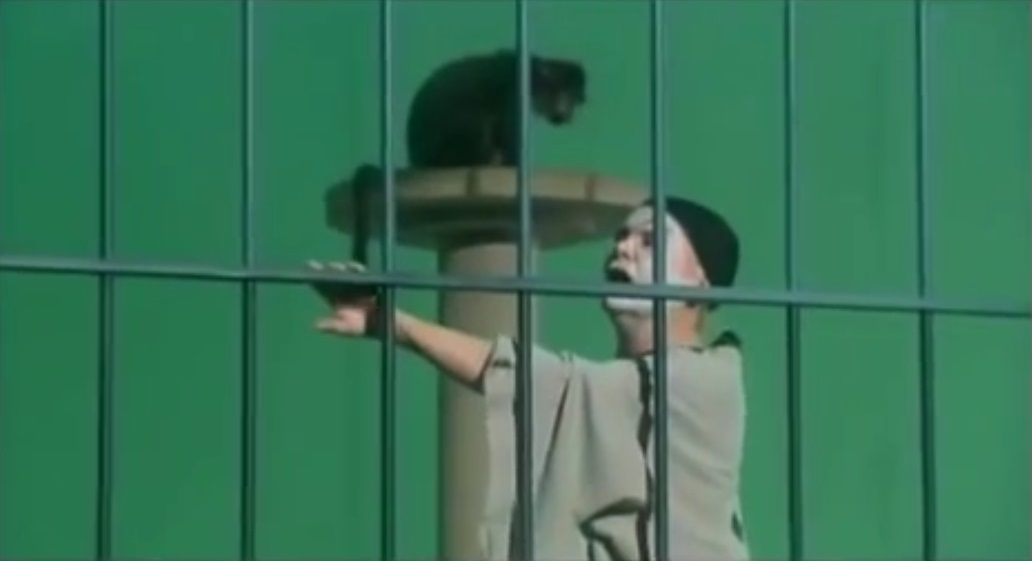Les Tréteaux de Maître Pierre
adaptation musicale et scénique d’un épisode d’El ingenioso Hidalgo Don Quijote de
la Mancha de Miguel de Cervantes

El Retablo de Maese Pedro,
an electrifying performance of a sovereign musical work. Grand
overture, Petrushka-parody (the rape
of Melisendra) declaimed by an overenthusiastic boy
chastened more than once, the whole assailed at last by the Knight of the
Doleful Countenance who draws his basso profundo sword to “flitter the fucker”. El Retablo de la Libertad de Melisendra, a puppet spectacle attended by Don Quixote
himself and Sancho Panza amidst the various
personages of the evening’s entertainment, including the animals of Renard (q.v.), the motley of Ensor (Falla himself appeared on stage as the landlord of the
inn).
A boy rolling a
hoop crosses the stage slowly as a clarinet plays at the very first, he is the
dragoman presenting each scene. The showman of the
title wears the informal garb of an itinerant trouper, gibus and ringmaster’s
coat thrust on à la Calder.
Sylvain Faye puppets, Titina Maselli décor...
Eric Dahan (Libération), “d’une précision et d’une vivacité qui font mouche, même s’il
reste à gagner un peu de souplesse.”
Renard
Histoire burlesque chantée et jouée d’après des contes populaires
russes

A triumphant
performance the work requires and gets. The deserts he’s crossed,
Stravinsky’s Renard, the endless misery, to
hear the Cock’s confession.
The Cock’s
barnyard dance is from Chaplin (The Gold
Rush). The Cat and the Ram, also the boy of the incipit a sort of Watteau
clown strolling along with hoop and amusedly watching the three cavorting as
they exult over Renard’s first defeat. Crime and blandishment, the basso falsetto notes of Renard’s second attempt recur in Threni. The
tail-plucking arioso is the finest shower onstage since the Met’s
La Gioconda
concluded the Dance of the Hours in Apollonian gold.
Pierre Boulez,
Ensemble Intercontemporain, the singers in Russian,
Michel Kelemenis choreography, Titina
Maselli set and costumes, Dominique Borrini lighting, Klaus Michael Grüber
mise en scène (Festival d’Aix-en-Provence, at the Vienna Festival), vd. Pierrot Lunaire for the “triptyque
insolite”.
“La
confrontation musique/théâtre est passionnante, car elle correspond à trois
dispositifs différents de mise en scène imaginés par Klaus Michael Grüber: l’opéra de Falla est monté de manière
traditionnelle avec orchestre dans la fosse et chanteurs sur la scène; pour
Stravinsky, les chanteurs sont dans la fosse avec les musiciens; pour Pierrot
lunaire, enfin, c’est l’inverse,
les instrumentistes sont sur scène avec la récitante” (Boulez, L’Express).
Pierrot Lunaire
Mélodrame pour récitante et cinq instruments

Stravinsky’s
clarinet pieces are an interlude auf der Bühne with the clown
again (vd. Renard)
and Schoenberg’s récitante
(Anja Silja), a lunatic
behind bars who begins the work in a plush armchair and rises to pace her cell
declaiming (onstage the evening began with Falla,
concluded with an extract from the Dialogue
de l’ombre double of Boulez, at the Théâtre du Jeu
de Paume from Pribaoutki,
“and lasted an hour and a half with much applause,” says a report).
The set by Gilles Aillaud, an immense set the
musicians share stage right as she makes herself up in white and puts on the
costume of a Pierrot, continuing all the while to speak in the manner of the
composition, throwing off musical notes brightly, darkly and recklessly,
uttering Giraud’s witty poems like a cabaret
performer struck by moonlight into great and fervid inspiration.
This in lieu of the lunar silhouette produced originally... No doubt the
geometry of the set is a foil to the arabesques of the score. The monkey on a
pedestal is perhaps from Losey’s Boom. The high walls are institutional green. Grüber’s staging of the conclusion is at all events a
liberation attended, as at the beginning (Les Tréteaux de Maître Pierre, q.v.), by all members of the production.
|
Nach
Bergamo, zur Heimat, Kehrt nun
Pierrot zurück. |
Renaud Machart (Le Monde), “une souplesse merveilleuse... d’un
phrasé galbé et lyrique, formidablement bien relayé”.
